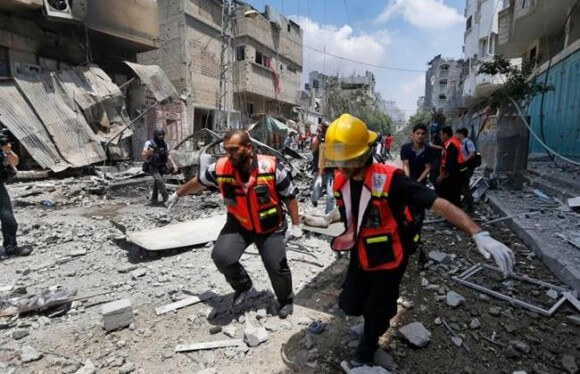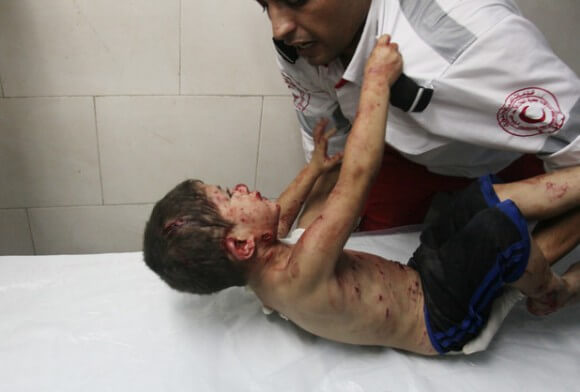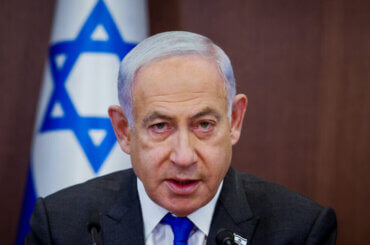
Israel bombed the ice vendor. The blazing summer, made worse by the absence of electricity, drove dozens of people to gather around a small store which used to sell ice. According to my friend who lives in Shejaiya, eleven drone missiles targeted the marketplace on July 30, including the ice store. Twenty-four civilians were killed in this particular assault, four of whom died before my eyes at Shifa hospital where I work. Twenty-four hours before this massacre, two artillery shells disabled the sole power plant in Gaza, exacerbating power deficiency from about 50% to more than 90%. This and the unilateral ceasefire Israel announced two hours before the attack gave people a false sense of security, which drove dozens of them to their fate at the ice store.
In Gaza havens are far, heavens are closer. The strike on Shejaiya market came only few hours after 16 people had been killed in an artillery strike on an UNRWA-run school. Those killed were refugees who fled their homes in the northern parts of Gaza in obedience to the threats they received from the “IDF” through phone calls, SMSs, leaflets, and random artillery on their area. The artillery, however, followed them to where they evacuated. The leaflets, it should be noted, specified the areas to which these people were forced to flee as well as the routes they were required to take. This was the sixth attack on an UNRWA school; just a week before, 21 people were killed in a similar strike on a school in Beit Hanoun north of Gaza. Yesterday, UNRWA announced that of 273,000 at the start of the 72-hour ceasefire, 187,000 displaced Palestinian civilians are still taking shelter in 90 UNRWA schools – an average of 2,077 people per school. But that’s just one third of the problem. One week after the Israeli ground invasion, UN humanitarian chief Valerie Amos estimated that 44% of the Gaza Strip was a no-go zone. This means that about twice as the number of refugees in UNRWA schools are or were taking refuge elsewhere, in their relatives’ houses, or at their friends’; in my house alone three uncles and their families were taking shelter. On August 6th UNRWA estimated that 30% of Gaza population was displaced. As such, areas already heavily populated have had their population double and were susceptible to daily artillery shelling. On several occasions, for example, shells hit a houses in my street, which is considered to lie in one of the safest areas – if such area existed.
In Gaza there is shortage in almost everything, but death is in abundance. In the past 30 days, I have seen whole families get obliterated, children left with no one to call family when they grow up, and beautiful little girls with scars in their faces, scars that will stay with them for the rest of their lives. I saw, moreover, young men pulled from under the rubble after being trapped there for a week. On my twitter account are uncountable stories, but I shall never forget little boy Kinan who lost all of his family, and who cried himself to sleep in his hospital bed calling for his father to come take him home; or Anas, a 16 year old teenager whose last breath I saw him take, and who, one hour before he was murdered, posted on Facebook demanding that if his house was going to be targeted that it should be done sooner than later, because he was too tired and wanted to sleep.

At Shifa hospital, I have seen all kinds of atrocities, but what pains me more than anything else is that most of the victims have been reduced to mere numbers. A boy whose picture showed him clinging to a paramedic was lucky enough to have a photographer at the scene and at the right time to document this heart-wrenching moment, a moment which went viral. Thousands, however, remain without luck. Even him, the lucky little boy, will soon be forgotten just as how the world has forgotten his ancestors who were expelled from their land more than six decades ago. For nearly seven decades, the Israeli crimes against the Palestinians went unaccounted for, always in the name of peace. Unless justice is sought and realized, peace will be false and wobbly. By “justice”, I mean a comprehensive process which restores the rights of the Palestinians inside and outside historical Palestine. Citizens of the world must be active participants in attaining such justice. This could be achieved, for example, through economic and academic boycott, through supporting arms embargo on Israel, calling for bringing Israel to the ICC, and through exposing and breaking the siege on Gaza. Moreover, the world needs to see what is happening in Gaza as a secondary symptom of the primary disease, that is, settler-colonialism and occupation. Without such conviction, violence will not be abolished and, regardless of what anyone has to say, the Palestinians will continue to resist.



Very sobering article– I appreciate it so much, Dr. Dabour. I have wanted to hear more from the heroic health care professionals/volunteers who are treating and caring for the people who are suffering this horrific assault and massacre, while experiencing it themselves. From what I’ve gleaned, you are all working in truly terrible conditions- short of supplies, short of sleep/any reprieve, short of everything except wounded and dying people and profound misery, pain, and loss.
Bless you in your work. Many of us ‘out here’ only want justice and an END to the OCCUPATION for all of the Palestinian people, and our numbers are growing.
Long live Palestine.
The first hand stories, as told by those who are dedicated to help long suffering human being, especially little children. Thank you for such vivid stories, that makes us feel we have witnessed the brutality of a hated occupier, and reminding us once again, the evil that results in our aiding, supporting, and arming of a nation with no conscience.
The picture of the injured little boy, so helpless, and being comforted by a Palestinian medic is heartbreaking. No parent can look at such sad pictures and not be moved to tears, and feel a hatred for those responsible.
How the US congress sleep at night, we will never know. To hear first hand stories by witnesses to Israel’s brutality and violence, and not be moved, is unbelievable.
We have a bunch of zionist slaves in congress, who seem to be moved and outraged only by rockets that have killed a couple or so of Israelis, but can closed their narrow little minds to the carnage caused by Israel’s violent onslaught, as if 2000 Palestinian lives, especially little babies, is justifiable, is reprehensible.
You think, Walid? Isn’t it the mindset as much as the money?
i would recommend going to Dr. Dabour’s blog and looking at the photograph he took of the boy (scroll). http://belalmd.wordpress.com/
Another medic, the young Dr. Bassel Abuwarda who worked closely with Dr. Mads Gilbert at Al-Shifaa Hospital has asked for help – please see his new website:
http://www.savegazaproject.org
Besides donations, there is a request for volunteers worldwide to help in a variety of ways.
Also on twitter:
@savegazaproject
@drbasselabuward